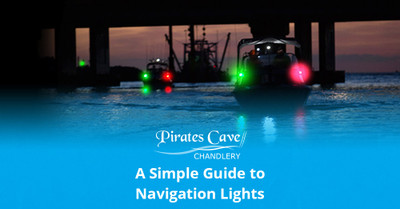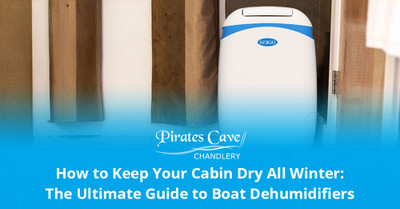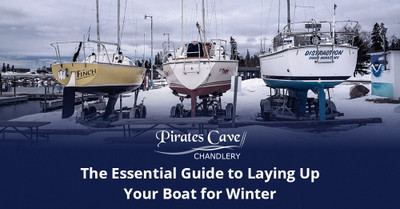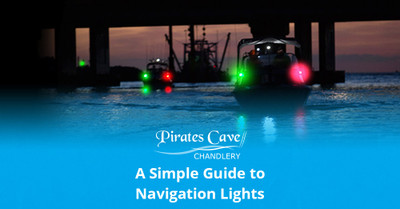26th Sep 2025
Navigation lights are an essential part of boating safety. They allow vessels to see one another in darkness or restricted visibility and, just as importantly, they tell other mariners what type of vessel you are, what you are doing, and which way you are going. The International Regulations for Preventing Collisions at Sea (COLREGs) set out strict requirements for navigation lights, and every skipper should know how to apply them.
General Principles
Navigation lights must be displayed from sunset to sunrise and in any condition of poor visibility such as fog, heavy rain, or mist. Their purpose is twofold: first, to make a vessel visible, and second, to indicate her heading, size, and sometimes her activities. The system is colour-coded: red always marks the port (left) side, green marks the starboard (right) side, and white is used for masthead, stern, and anchor lights. Together these lights form a language that lets you interpret what another vessel is doing, even in total darkness.
LED vs Traditional Navigation Lights
Traditional navigation lights use incandescent or halogen bulbs. These produce light by heating a filament, which wastes a lot of energy as heat. LEDs, on the other hand, are semiconductors that emit light directly when current passes through them. As a result, LED navigation lights are far more energy-efficient, drawing only a fraction of the power. This makes them especially useful on sailing yachts and smaller boats where battery capacity is limited.
Power Consumption & Battery Life:
Because LEDs use much less power, they have a huge advantage for vessels that spend nights at anchor or on long passages. A set of incandescent lights left on all night can significantly drain a battery bank, whereas LEDs barely dent the reserves.
Lifespan & Reliability:
Incandescent bulbs have a relatively short lifespan, often only a few hundred to a couple of thousand hours, and the filament is fragile. Vibration from an engine, pounding seas, or even just age can cause them to fail suddenly. LEDs, by contrast, can last tens of thousands of hours. They also have no filament, making them far more resistant to vibration and shock—ideal for boats that operate in tough conditions.
Durability & Sealing:
LED fixtures are usually sealed units, which means the LEDs themselves are waterproof and corrosion-resistant. Traditional navigation lights often use replaceable bulbs, which can corrode at the contacts or suffer from poor connections. While sealed LEDs are more reliable, the drawback is that if one fails, the whole fitting usually needs replacing rather than just a bulb.
Light Quality & Compliance:
Navigation lights must meet strict visibility standards—specific colours, intensities, and arcs of visibility. Traditional incandescent bulbs naturally produce a full spectrum of light and then rely on coloured glass or plastic lenses to give the correct red, green, or white. LEDs, however, can be engineered to emit the exact wavelength required, which gives a purer colour and often better visibility at distance. That said, cheap non-certified LED lights can fall short of the required standards, so it’s important to choose marine-approved, COLREG-compliant LEDs.
Cost:
LED navigation lights are more expensive upfront, sometimes two to three times the cost of incandescent fixtures. However, because they use far less power and last much longer, they usually save money over the long term. For boats that do a lot of night sailing or long passages, LEDs almost always pay for themselves.
Heat & Safety:
Incandescent bulbs get hot, which can cause wear on fittings and even lead to melted lenses over time. LEDs run much cooler, which makes them safer and helps extend the life of the housing.
Power-Driven Vessels
A power-driven vessel under 12 metres in length is allowed a relatively simple setup. Such a vessel may show an all-round white light visible through 360 degrees, combined with red and green sidelights. Slightly larger power vessels, between 12 and 50 metres, are required to carry a masthead light placed forward, shining over an arc of 225 degrees, together with a stern light shining 135 degrees aft. They also carry red and green sidelights that mark the port and starboard beams. Power-driven vessels over 50 metres must carry two masthead lights, one forward and one higher aft, in addition to the sidelights and stern light. This second masthead light helps other mariners distinguish large vessels from smaller ones.
Sailing Vessels
A sailing vessel under sail alone shows a different arrangement. She carries red and green sidelights and a stern light, but no masthead light. Vessels under 20 metres in length may choose to use a single tricolour lantern at the top of the mast instead, which combines port, starboard, and stern lights into one. However, if the vessel is using her engine, she is classed as a power-driven vessel and must display the appropriate power lights, even if her sails are up.
Small Craft and Oared Vessels
Smaller craft such as dinghies, kayaks, and rowing boats are not exempt from lighting requirements. When operating at night, they should carry at least a torch or lantern showing a white light, which can be displayed in time to prevent a collision. Although the rules allow some flexibility, it is always safest to make oneself as visible as possible to other vessels.
Anchored Vessels
A vessel at anchor must also be lit. A small vessel under 50 metres in length shows one all-round white light where it can best be seen, usually at the bow or midships. Larger anchored vessels over 50 metres are required to display two all-round white lights: one forward and one aft, with the aft light set higher than the forward. These lights indicate clearly to others that the vessel is stationary and not underway.
Special Types of Vessels
Certain vessels engaged in special activities display additional light combinations to warn others of their restricted ability to manoeuvre. A vessel engaged in towing will carry one or more extra masthead lights, depending on the length of the tow, and a yellow towing light above the stern light. Fishing vessels have their own signal: a trawler shows green over white, while a vessel fishing with nets, lines, or other gear that restricts her movement shows red over white - easily remembered by the rhyme “red over white, fishing at night.” Vessels restricted in their ability to manoeuvre, such as dredgers or cable layers, show a vertical line of red, white, red. Finally, a vessel not under command (NUC), meaning unable to manoeuvre due to some exceptional circumstance, displays two all-round red lights in a vertical line, a warning to all others to give her a wide berth.
Remembering the Lights
Many sailors rely on simple memory aids. “Red to port, green to starboard” is the most basic, while “red over white, fishing at night” and “two reds, the ship is dead” help recall fishing and NUC signals. The essential idea is that these lights form a code that, with practice, you can interpret instinctively on the water.
Conclusion
Understanding and displaying the correct navigation lights is not only a legal requirement but a matter of life and death on the water. Correct lighting prevents collisions, helps identify other vessels, and allows safe passage even in the darkest conditions. Every skipper should make sure their lights are correctly installed, properly maintained, and always used at the right times.



